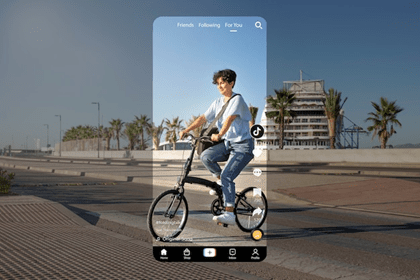Just as each year brings change, so is the world of digital marketing rapidly evolving too.
As we approach 2024, a new wave of trends is set to reshape next year’s digital marketing landscape. New trends and technologies like artificial intelligence (AI), voice search, ephemeral content and many more are here to redefine the way businesses connect with their audiences online.
In this blog, we’ll take you on a journey into the digital marketing trends of 2024, offering insights and strategies to help you prepare for the year ahead.
1. AI-powered Personalized Marketing

In 2024, artificial intelligence (AI) and machine learning (ML) are set to continue their advance into the world of digital marketing.
For businesses, marketers can leverage AI and machine learning’s ability to analyse vast data sets to better understand individual customer preferences and behaviours. In turn, this allows tailored content, product recommendations, and real-time customer service to be delivered.
The advanced capabilities of AI will likely see to hyper-personalized content delivery and the introduction of advanced chatbots for real-time customer engagement. These technologies will also enable predictive analytics to better understand consumer behavior and tailor marketing efforts with unprecedented accuracy.
How might it work?
Example: Personalized Content Delivery
An e-commerce business can leverage AI and ML to provide a personalized shopping experience. As a user browses the website, the AI-powered backend analyses their behaviour and preferences in real-time, suggesting products based on their past purchases and current browsing patterns. The result? A unique shopping experience highly tailored to each person’s needs and wants, with higher conversion rates and happier customers.
2. Video Marketing Evolution

Video content has reigned supreme online for years now, especially in marketing. It’s only going to gain more traction in 2024 if its popularity is any indication. Short-form videos, live streaming, and interactive video formats will see greater dominance of the online landscape.
Whether it’s Facebook, Instagram, YouTube or TikTok, short-form videos can captivate audiences in seconds while live streaming offers incredible potential for engaging them in real-time. Moreover, interactive video content is the latest evolution in online content that viewers can actively engage with, with tons of engaging possibilities like clickable elements, quizzes, and choose-your-own-adventure narratives.
Compared to plain text and imagery, videos can tell stories, deliver messages, and facilitate real-time interactions, making them incredible tools for attracting and engaging audiences on a much higher level. And the best part is, video marketing is accessible to just about all businesses both big and small, meaning everyone’s likely getting into it sooner or later.
How might it work?
Example: Short-Form Videos for Café Promotion
Imagine you own a café, and you want to promote your daily specials. Videos let you create vibrant content showcasing your baristas crafting exquisite coffee and pastries. These short videos are perfect for sharing on social media, offering a tantalizing glimpse of your offerings, and drawing customers into your café.
3. Virtual Reality (VR) and Augmented Reality (AR) Marketing

Although often associated with gaming, the immersive technologies of VR and AR are also here to reshape marketing by virtue of their interactive experiences.
When used in digital marketing, VR and AR provide marketers a means to showcase products and brands with incredible immersion. The highly interactive experience builds excitement and confidence among customers, who can engage with brands and what they have to offer in innovative ways to make informed purchasing decisions.
Although imagery and video make great visual elements as is, VR and AR are a cut above them in their engagement potential. Picture yourself as a cosmetics brand: A customer can use their phone to see how your new eyeliner looks on them in real-time! The opportunities are endless.
How might it work?
Example: Virtual Showroom
Consider an automotive company using VR to create virtual showrooms for their vehicles. Customers can put on VR headsets and explore the car’s interior, test its features, and even take it for a virtual test drive. This immersive experience not only informs potential buyers but also creates a memorable and exciting interaction with the product.
4. Voice Search in SEO

Users nowadays are increasingly turning to voice search for quick, hands-free access to information. In 2024, voice-activated devices, assistants, and search are likely to grow even further in popularity.
This trend necessitates a shift in SEO strategies for businesses as voice-based queries, which tend to be more conversational and question oriented, enter the fray. In practice, marketers will need to focus on long-tail keywords and natural language in optimizing their content, where they can provide concise, direct answers to question-based queries that users voice out.
How might it work?
Example: Local Business
Imagine you run a local coffee shop, and a user asks their voice-activated device, “Where’s the best coffee shop near me?” Optimizing your website and Google My Business listing for local SEO and voice search ensures that your coffee shop is recommended as the answer, driving potential customers to your location.
5. Data-driven Storytelling

The art of storytelling in digital marketing has become increasingly intertwined with data-driven insights. In 2024, data-driven storytelling is set to become an even more important strategy for engaging and captivating audiences.
Stories have always been a fundamental part of human communication, where they provide context, create emotional connections, and help people make sense of complex information. By using data to fuel what and how stories are told, businesses can craft compelling narratives that resonate with their target audience on a deeper level.
How might it work?
Example: Data-Driven Content Marketing
Let’s say you’re a fitness equipment manufacturer, and your data shows a spike in at-home workouts. You can craft a data-driven story that revolves around the rise of home fitness. You might share statistics on the benefits of working out at home, along with personal stories from customers who have transformed their lives through your products. This combination of data and personal narratives creates a powerful and engaging piece of content.
6. Ephemeral Content and Stories

Platforms like Instagram and Snapchat are all the rage thanks to ephemeral content. Leveraging peoples’ psychological drive of FOMO, their popularity isn’t likely to be dropping anytime soon. It’d be quite the opposite as 2024 will see even more content shared.
It’s simple. The timely nature behind these “stories” provide businesses a great opportunity for engaging their audiences in real-time while also fostering a sense of authenticity and connection. As such, utilising stories for brand storytelling, behind-the-scenes glimpses, and flash sales will be an integral part of digital marketing strategies in the years to come.
For businesses, ephemeral content is especially useful for telling a brief, compelling story, or showcasing a new product in action. Their temporary yet authentic nature are not only able to grab viewers’ attention instantly, but also help brands connect with their audience on a more personal level.
How might it work?
Example: Café Specials on Instagram Stories
Imagine you own a café, and you want to promote your daily specials. Using Instagram Stories, you can create ephemeral content that showcases the day’s menu, special coffee brews, and behind-the-scenes moments in the café. These short-lived, visually engaging posts prompt your audience to act quickly, visit your café, and engage with your brand.
7. Content Personalization

Personalised content isn’t exactly new, but its growing prevalence is likely to see it take centre stage in 2024 and beyond as audiences look forward to more tailored experiences.
Together with data analytics as its fuel, businesses will likely look to delivering content and product recommendations tailored to individual user preferences. Personalized emails, product suggestions, and website experiences will be the norm, paving the way for greater engagement among audiences.
When customers see tailored content in their inboxes, they’ll be more inclined to engage and interact with a brand on a deeper level. Through personalized content, this spells great news for any business looking to up their conversions.
How might it work?
Example: Personalized Product Recommendations
Imagine you run an e-commerce website. With content personalization, you can analyse a user’s past purchases, browsing history, and search queries to recommend products they are likely to be interested in. This tailored approach not only increases the chances of a purchase but also provides a delightful shopping experience.
8. Privacy and Data Protection

Data privacy is becoming a big deal these days, and it’s no exception in digital marketing. By 2024, it’ll be paramount that businesses adapt to stricter regulations and a more privacy-conscious consumer base. Transparency in data collection and use along with ethical data practices will be crucial in building and gaining consumer trust.
What this means is that businesses will have to ensure data is encrypted both in transit and at rest to protect it from unauthorized access. Clear, concise consent mechanisms should be implemented to give users control over how their data is collected and used. Also, businesses should only collect data that’s necessary for business purposes.
How might it work?
Example: User Data Protection
Imagine you operate an e-commerce platform. By implementing robust data protection measures, you assure users that their personal information, such as particulars, credit card details and addresses, is safe from breaches. This trust encourages users to make purchases and return to your platform.
Conclusion
The digital marketing landscape for 2024 is looking rich in innovation and change. With a variety of trends abound, businesses should look to embrace AI, leverage engaging forms of content, take note of emerging technologies, and respect data privacy. If current audience preferences are anything to go by, personalization and immersive experiences are your keys to success in the digital marketing world.
As 2024 approaches, remember that adaptability and innovation are your allies in the ever-evolving world of digital marketing. Stay tuned for what promises to be an exciting year for the industry, and prepare to seize these trends as opportunities to excel in the digital realm.


